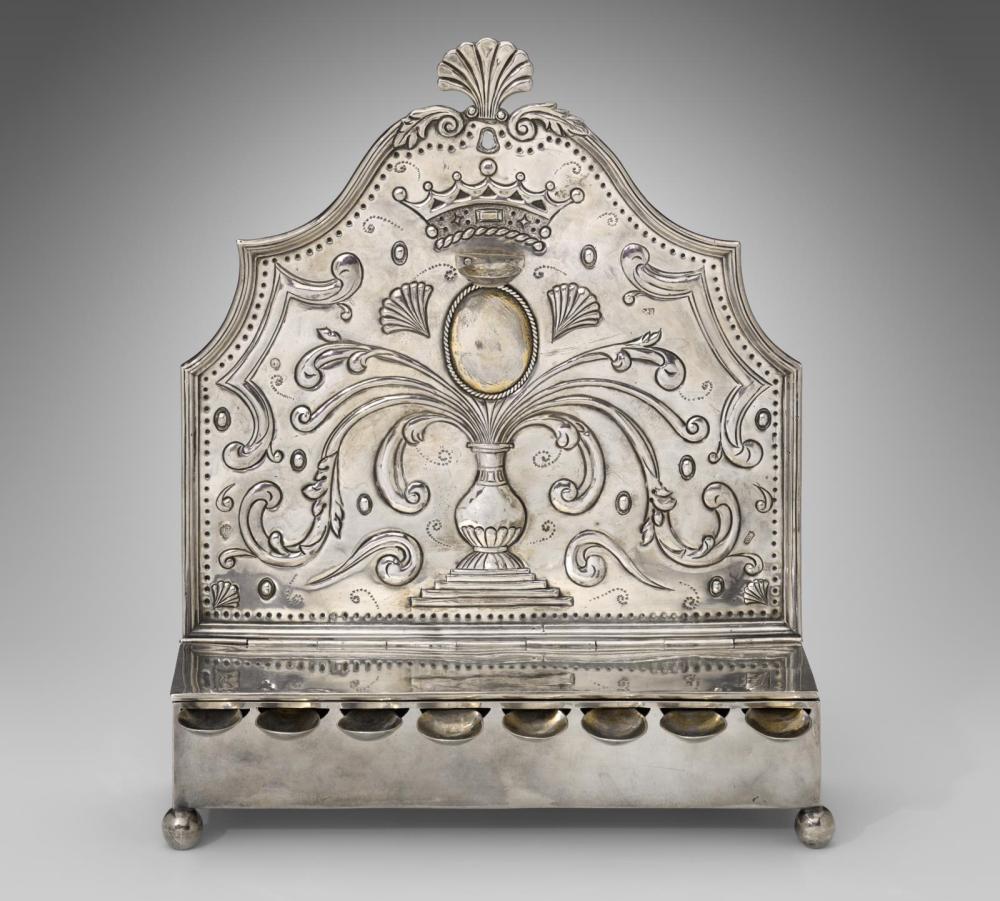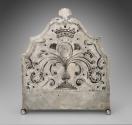Advanced Search
Hanukkah lamps are lit for eight consecutive nights during the festival marking the purification and rededication of the Temple of Jerusalem in 164 B.C.E. This lamp is of the so-called bench type, that is, it was designed to be placed on a surface rather than to be hung on a wall or a door. It is decorated in repoussé with, in the centre, a vase with spilling flowers surmounted by an oval cartouche, topped in turn by a crown symbolising the Torah. Shells are seen at the top of the backplate, in its bottom corners, and flanking the central cartouche.
This lamp was made by Johannes Winter (born 1703, Groningen) in 1730, the very year he entered his mark. It is fully marked on the base and backplate with maker’s mark, city mark, date mark, and silver guarantee mark. Winter was trained by the Groningen silversmith Hindick Jan Spanjer, and it has been suggested that the chased design of this lamp can be related to silver produced in this city (especially teapots). In 1731 Winter married Anna van Hoven, who was probably related to the Amsterdam silversmith Pieter van Hoven, the most prolific Dutch maker of Jewish silver. As far as we know, however, this lamp is the only Jewish silver object made by Johannes Winter.
The chased floral and strapwork decoration is very finely done and speaks to a transitional moment between the restraint of 17th century silver design and the more exuberant Rococo decoration and forms to come later in the 18th century. The cartouche, shells, and dynamic vegetal motifs seen in Johannes Winter’s lamp point to his knowledge of the wider European Rococo visual language.
Whereas brass Dutch Hanukkah lamps are very common, silver Hanukkah lamps from the Netherlands are rare. Only twelve sixteenth and eighteenth-century silver lamps are known to survive, including examples in the Rijksmuseum, the Royal Collection in the Netherlands, and the Jewish Museum, New York.
Hanukkah lamp
Johannes Winter (Dutch, 1703–after 1731)
Dutch
1730
Medium/Technique
Silver
Dimensions
30 × 25 × 7.5 cm (11 13/16 × 9 13/16 × 2 15/16 in.)
Credit Line
Museum purchase with funds donated by Rose-Marie and Eijk van Otterloo, in support of the Center for Netherlandish Art
Accession Number2021.111
CollectionsJudaica
ClassificationsSilver
Hanukkah lamps are lit for eight consecutive nights during the festival marking the purification and rededication of the Temple of Jerusalem in 164 B.C.E. This lamp is of the so-called bench type, that is, it was designed to be placed on a surface rather than to be hung on a wall or a door. It is decorated in repoussé with, in the centre, a vase with spilling flowers surmounted by an oval cartouche, topped in turn by a crown symbolising the Torah. Shells are seen at the top of the backplate, in its bottom corners, and flanking the central cartouche.
This lamp was made by Johannes Winter (born 1703, Groningen) in 1730, the very year he entered his mark. It is fully marked on the base and backplate with maker’s mark, city mark, date mark, and silver guarantee mark. Winter was trained by the Groningen silversmith Hindick Jan Spanjer, and it has been suggested that the chased design of this lamp can be related to silver produced in this city (especially teapots). In 1731 Winter married Anna van Hoven, who was probably related to the Amsterdam silversmith Pieter van Hoven, the most prolific Dutch maker of Jewish silver. As far as we know, however, this lamp is the only Jewish silver object made by Johannes Winter.
The chased floral and strapwork decoration is very finely done and speaks to a transitional moment between the restraint of 17th century silver design and the more exuberant Rococo decoration and forms to come later in the 18th century. The cartouche, shells, and dynamic vegetal motifs seen in Johannes Winter’s lamp point to his knowledge of the wider European Rococo visual language.
Whereas brass Dutch Hanukkah lamps are very common, silver Hanukkah lamps from the Netherlands are rare. Only twelve sixteenth and eighteenth-century silver lamps are known to survive, including examples in the Rijksmuseum, the Royal Collection in the Netherlands, and the Jewish Museum, New York.
Marks
Fully marked on the base and backplate with maker’s mark, city mark, date mark, and silver guarantee mark.
ProvenanceAbout 1978, sold by Mozes Heiman Gans (dealer; b. 1917– d. 1987), Premsela and Hamburger, Amsterdam to Bernard Finkelstein, Antwerp; by descent to his son, Gideon Finkelstein, Antwerp and Raanana, Israel; February 1, 2021, Finkelstein sale, Pierre Bergé et Associés, Paris, lot 13, to Salomon Lilian (dealer), Amsterdam; 2021, sold by Salomon Lilian to the MFA. (Accession Date: February 24, 2021)



